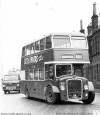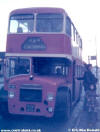Special Features Focus on : Lodekka Looks
Contributed by Douglas G MacDonald, November 2003 (and following on from the previous feature on back ends)
If it was an insult to be visually compared to the rear quarters of an omnibus, would it be any more complimentary to be facially described as being akin to the front of such a vehicle? In the case of many bus types, the answer would have to be a resounding no, but perhaps the Bristol Lodekka would provide some form of flattery! A handsome vehicle which had a distinctive ‘face’ and classic lines contemporary to its époque, even this bonnie bus had to undergo beauty treatment before becoming pleasing to the industry and public eye.
The front-end styling of the prototypes was based on an exposed radiator grille, like the K type, but much bigger and downright ugly! When it came to the pre-production models there was a marked improvement, in the shape of a longer but narrower grille with large slats, and the makeover was complete by a further alteration to the grille.
Central took delivery of the first of over 120 LD models in 1955. B1–10 came with the long rad, but B11-19 were delivered wearing the shortened, squarer grille, which was to become Bristol’s standard until 1963. The last handful of LDs from the ’55 order differed in two ways. Not only did they carry the long rad, but they had coach seating, reducing the capacity to H29/27R, primarily for use on the 242-244 Limited Stop and other longer-haul services. Thereafter, the short grille became instantly recognisable until CSMT’s last LD (B129) and on into the FSF deliveries, and it was B160 which was the first of the Central fleet to have had another makeover – Bristol’s new metallic, wavy-line grille, complete with Lodekka legend along its base. This, of course, also became standard all the way through the remainder of the company’s intake of 350+ Bristols in FS, FSF and FLF guises.
Apart from the actual grille, one other cosmetic item should be mentioned - the silver strips on either side of the radiator filler cap. The early deliveries didn’t have such heavy make-up; the later ones did, but often lost their extra good looks through time.
The following photos put the company’s Lodekkas full-face into the enthusiast’s mirror. As you’ll see, there could be anomalies too - long rads replaced by short versions, and even the reversal of this situation. Why would a newer, small-mouthed Lady Lodekka end up with a long face? Central’s respected and long-serving former manager John Whittle offers the likely explanation : Traction House engineering staff had their own fibreglass moulds for making replacement front sections for accident-damaged LDs, and initially the ‘plastic surgeons’ used the long rad.
The non-standard destination screens were a give-away to Central’s youthful Lodekkas, but as a young lad, I actually learned to identify the various vehicle marques by their radiator grilles - not just Bristols, but the range of Leylands, Arabs and Lowlanders, etc. Comparisons of modern-day pin-ups to the glamour girls of another era may be wrong to make, but surely, even in the 21st century, the distinctive demeanour of a revolutionary bus-beauty would still hold her own against the supposedly sleek and sophisticated models on show on our streets today.





